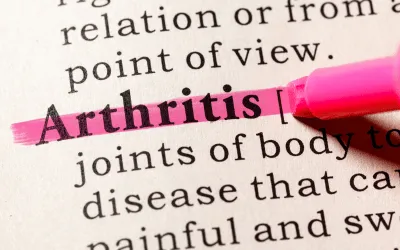About Arthritis
As the nation’s #1 cause of disability, arthritis affects nearly 60 million adults and 300,000 children. Over 100 types of arthritis and related conditions damage the joints and often other organs.
How can we assist you?
Helpful Tools for You

New Approach in Osteoarthritis Research: Targeting Early Intervention for Better Outcomes
Osteoarthritis (OA) is the most common form of arthritis, impacting millions of people globally. It is one of the top 10 conditions contributing to Years Lived with Disability, a measure that reflects the disease's significant impact on quality of life. Despite the prevalence of OA, especially in older adults, no treatments currently exist that can slow its progression. However, new research from Boston University’s Chobanian & Avedisian School of Medicine may offer a promising direction for the future of OA treatment by focusing on early intervention.
The Challenge of Treating Osteoarthritis
Osteoarthritis is a degenerative joint disease that primarily affects the cartilage and bones in the joints. Over time, the wear and tear on the joints cause pain, stiffness, and reduced mobility. To date, efforts to develop effective treatments for OA have largely been unsuccessful, partly because animal models used in research do not accurately reflect the human experience of OA, which develops slowly over many years and often without a preceding injury.
Dr. David T. Felson, MD, MPH, a professor of medicine and epidemiology at Boston University, has suggested a shift in research focus. He and his colleagues propose that studying individuals after they sustain knee trauma, such as an anterior cruciate ligament (ACL) tear, could provide valuable insights into how OA develops and progresses in humans.
Understanding the ACL-OA Connection
While many people recover from ACL injuries without developing chronic knee problems, a significant number go on to experience persistent pain and eventually develop osteoarthritis. The researchers reviewed data from the MOON (Multicenter Orthopaedic Outcomes Network) cohort, which followed 2,340 patients undergoing ACL reconstruction. The study found that 26% of patients experienced moderate knee pain in daily activities, such as walking or climbing stairs, even after recovering from surgery. Additionally, 16.6% had knee pain scores suggesting moderate pain following their ACL repair.
By identifying patients at high risk for developing post-injury osteoarthritis, researchers hope to create early interventions aimed at preventing the disease from progressing. "This approach is especially valuable in targeting young adults who, after a knee injury, may have significant pain and disability for many years," explained Dr. Felson.
The Potential of Early Intervention
The study’s findings suggest that patients who are at risk for developing osteoarthritis after joint trauma could be a valuable group to focus on for OA treatment trials. Currently, non-surgical treatments for OA, such as nonsteroidal anti-inflammatory drugs (NSAIDs), provide only temporary relief and carry potential side effects. While exercise and weight loss are beneficial, long-term adherence to these programs can be challenging. Additionally, the rising rates of knee replacement surgeries indicate that many patients do not find relief from nonsurgical methods.
By targeting individuals at the early stages of OA development—those who have sustained an ACL tear or similar joint trauma—researchers hope to find treatments that can slow the disease before it progresses to severe pain and disability.
Why This Matters for the Future of OA Treatment
The implications of this research are significant for the millions of people living with osteoarthritis. If early intervention strategies can be developed to prevent OA in high-risk groups, it could reduce the need for invasive surgeries and improve the quality of life for those affected by joint injuries. Moreover, early treatment could delay or even prevent the onset of osteoarthritis, a condition that currently has no cure.
The American Arthritis Foundation is committed to supporting research that aims to improve the lives of individuals with OA. As this new approach to targeting early intervention in high-risk individuals unfolds, there is hope that we may finally see breakthroughs in the treatment of osteoarthritis.
Osteoarthritis continues to be a leading cause of pain and disability, but innovative research like that from Boston University is paving the way for new approaches to treatment. By focusing on high-risk groups who sustain joint trauma, scientists are one step closer to developing effective interventions that can slow or even prevent the progression of osteoarthritis. Early diagnosis and treatment could provide relief to millions, improving quality of life and reducing the need for invasive procedures.
Effects of Arthritis

Cause of Disability
In the United States, 23% of all adults, or more than 54 million people, have arthritis. It is a leading cause of work disability, with annual costs for medical care and lost earnings of $303.5 billion.

Workforce Effects
Sixty percent of US adults with arthritis are of working age (18 to 64 years). Arthritis can limit the type of work they are able to do or keep them from working at all.

Global Impact
In fact, 8 million working-age adults report that their ability to work is limited because of their arthritis. For example, they may have a hard time climbing stairs or walking from a parking deck to their workplace.
Promoting Interventions That Reduce Arthritis Pain
American Arthritis Foundation recognizes several proven approaches to reduce arthritis symptoms:
Be active. Physical activity—such as walking, bicycling, and swimming—decreases arthritis pain and improves function, mood, and quality of life. Adults with arthritis should move more and sit less throughout the day. Getting at least 150 minutes of moderate-intensity physical activity each week is recommended.
Protect your joints. People can help prevent osteoarthritis by avoiding activities that are more likely to cause joint injuries.
Talk with a doctor. Recommendations from health care providers can motivate people to be physically active and join a self-management education program. Should your arthritis be interfering with your activities of daily living you may be a candidate to receive many new treatments, and learn how to reverse the arthritis condition.
Have a question?
We're Here to Help
By providing my phone number, I agree to receive text messages from the business.


